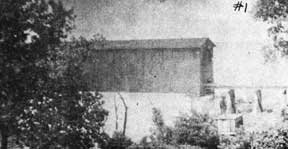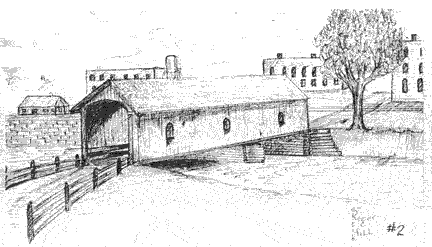
Discover rewarding casino experiences. 
Click on the Flag for More Information |
What was that light ahead this time of night, 10:00? No train was due. At nine all had been well. The light seemed to grow larger. He began to trot towards it, stepping rhythmically, concentrating on the light rather than his footfall. As Manning approached the next to last span of the bridge, he stopped. "Oh, hell," he spat. The light was a flame. With the expletive, fingers of fire leapt to a wooden side brace to writhe like a fiery snake to the roof. There'd be no chance to squelch the fire alone and overhead. He turned to run back the way he'd come. He heard a pop, a thud as a plank already had fallen to the tracks. The flames were eating towards him.
Manning commenced running again, winded when reaching the north bank of the river where he could see the covered bridge suddenly burst into blazing spectacle. In just a half hour the impressive bridge was a total loss. No cause was ever discovered as to how the fire had begun. No train chuffing spark had recently passed. The place Watchman Manning saw the initial flame was clearly in the open so hardly smoldering when he'd walked past the site previously. Was the fire of suspicious origin? No aspersions were cast in the latest Whiteside County history, 1968, about that fire of the covered bridge between Sterling and Rock Falls in 1888 although it was reported that at the time railroad engineers were on an extended strike and had been since February extending into January, 1889. The bridge however had been subject of some controversy for some years prior ... Not because it was a wooden covered one but as one element in several among as many as three railroad companies vying for the right-of-way across Whiteside County years before and continuing. At least three separate routes had been debated, "widely divergent, they were in complex negotiations." So "complex" that what with failures and consolidations and all the common enough machinations of railroad companies then, they went on for years and are too complicated to repeat here. In the 1850s railroads were thought to be a must-have for a town to prosper. Where once a mill site marked success, by mid-century it was railroads and only a vivid imagination or depth of knowledge of those financial dealings could explain the intensity of feeling on the part of some sites to receive a depot while others did not. This was evident from the very first as the railroads plodded across Whiteside 'midst rough talk, angry creditors, stubborn directors of boards, town councils rights-of-way owners and more. It was an unsettled time which lasted more than a few decades. The "Whiteside Investigator," forerunner of the "Fulton Journal," printed this in 1854, the reporter saying, "There was a deep-rooted vengeance in their breasts and some made threats against the first train, I pity the first train passing over the road in the night for all time to come." It was also reported that a group of irate workers traveled to Dixon where they attacked a construction camp of 200 workers. These were just a couple examples in the background of a continuing story. Was it still vengeance in connection with the engineers strike that was the cause of the covered bridge fire in 1888? Not because it was covered but it was a temptation AND a huge investment of the railroad company. How better to hit them where it hurt ... In the pocketbook?
The bridge was 1,200 feet long, nearly a quarter of a mile, and said to be the longest covered bridge in America at the time. It had cost $45,000, a huge sum in the late nineteenth century when it was built, 1883. We little think today of the prominence of covered bridges here in Illinois but they were fairly common. But why a covered railroad bridge? We think first today of safety. A railroad engine powered by steam made by burning coal and wood, shooting sparks out as it chugged along, could not have been part of the safety issue ... Did they glide across the covered span? The picture here (#1) was taken from the Whiteside County History, 1968, by the late Wayne Bastian, certainly a rare view. Wooden bridge, likely a wood shingle roof, it was a bonfire waiting to happen. And rumor was rife with suggestions everywhere of plots including one, we suppose, in those unsettled times in railroading that a man named "Dynamite" Bowles(!) was arrested in Chicago, identified by an engineer who'd seen him in Fulton lurking about suspiciously. He'd disappeared so his hotel room had been searched where they'd found a container of combustible vitriol(!) and a sack of dynamite sticks enough to do considerable damage. Those were consigned to the depths of the nearby Mississippi River. But no other connection was made to the occasion of the covered bridge fire ... Was "Dynamite" Bowles its instigator? It's a good story, eh? The covered bridge was immediately replaced with an uncovered one using the same sandstone piers which hadn't been damaged. That bridge existed until the 1920s when it, too, ironically, burned. A third bridge was its replacement on the venerable piers and all-in-all that history of bridges is now but a footnote to history. Surprisingly, perhaps, another covered bridge, the drawing of it here (bottom left) by the late Roger Hill whose fertile imagination and ready pen did hundreds of sketches of Stephenson County's past, is from the county history of 1970. The bridge was reported to have been built on East Stephenson Street, Freeport, in 1864, a few years before residents voted in 1856 to obtain a loan for $3,000 to build a replacement of a simple one from 1840. The one in 1864, the third, was a private enterprise by John Clark who would charge a toll, as many were in those early times. At the time of the 1856 construction a long trestle had to be added because of the low, swampy land on the east bank of the Pecatonica. So the covered bridge of 1864 had to be long and commodious to carry traffic, solid ground to solid ground. Within twenty years the covered bridge had to be taken down because it had become unsafe and too narrow for "modern day" travelers. The new bridge in 1883 was iron and cost $30,000, an enormous amount then and it lasted only eighteen years. When in 1901 it was replaced by a very substantial twentieth century one (1901) because it would carry street cars as well as a double lane of wagons and other traffic. The days of the old fashioned covered bridge were gone. The Stephenson County history does state, however, an interesting fact that all the first county bridges were built of woodheavy oak or walnut trussesand "many over the river were covered to protect them from rotting." There's our answer. Next WeekMore on covered bridges, northern Illinois.
|




